TFIIIC localizes budding yeast ETC sites to the nuclear periphery
- PMID: 22496415
- PMCID: PMC3395662
- DOI: 10.1091/mbc.E11-04-0365
TFIIIC localizes budding yeast ETC sites to the nuclear periphery
Abstract
Chromatin function requires specific three-dimensional architectures of chromosomes. We investigated whether Saccharomyces cerevisiae extra TFIIIC (ETC) sites, which bind the TFIIIC transcription factor but do not recruit RNA polymerase III, show specific intranuclear positioning. We show that six of the eight known S. cerevisiae ETC sites localize predominantly at the nuclear periphery, and that ETC sites retain their tethering function when moved to a new chromosomal location. Several lines of evidence indicate that TFIIIC is central to the ETC peripheral localization mechanism. Mutating or deleting the TFIIIC-binding consensus ablated ETC -site peripheral positioning, and inducing degradation of the TFIIIC subunit Tfc3 led to rapid release of an ETC site from the nuclear periphery. We find, moreover, that anchoring one TFIIIC subunit at an ectopic chromosomal site causes recruitment of others and drives peripheral tethering. Localization of ETC sites at the nuclear periphery also requires Mps3, a Sad1-UNC-84-domain protein that spans the inner nuclear membrane. Surprisingly, we find that the chromatin barrier and insulator functions of an ETC site do not depend on correct peripheral localization. In summary, TFIIIC and Mps3 together direct the intranuclear positioning of a new class of S. cerevisiae genomic loci positioned at the nuclear periphery.
Figures
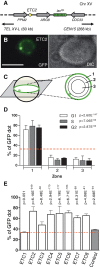

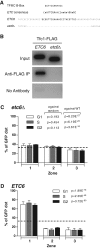

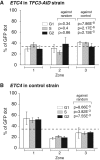
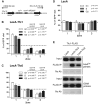


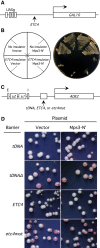
Similar articles
-
TFIIIC binding sites function as both heterochromatin barriers and chromatin insulators in Saccharomyces cerevisiae.Eukaryot Cell. 2008 Dec;7(12):2078-86. doi: 10.1128/EC.00128-08. Epub 2008 Oct 10. Eukaryot Cell. 2008. PMID: 18849469 Free PMC article.
-
Telomere anchoring at the nuclear periphery requires the budding yeast Sad1-UNC-84 domain protein Mps3.J Cell Biol. 2007 Dec 3;179(5):845-54. doi: 10.1083/jcb.200706040. Epub 2007 Nov 26. J Cell Biol. 2007. PMID: 18039933 Free PMC article.
-
High-level activation of transcription of the yeast U6 snRNA gene in chromatin by the basal RNA polymerase III transcription factor TFIIIC.Mol Cell Biol. 2004 May;24(9):3596-606. doi: 10.1128/MCB.24.9.3596-3606.2004. Mol Cell Biol. 2004. PMID: 15082757 Free PMC article.
-
TFIIIC bound DNA elements in nuclear organization and insulation.Biochim Biophys Acta. 2013 Mar-Apr;1829(3-4):418-24. doi: 10.1016/j.bbagrm.2012.09.006. Epub 2012 Sep 21. Biochim Biophys Acta. 2013. PMID: 23000638 Free PMC article. Review.
-
Extra-transcriptional functions of RNA Polymerase III complexes: TFIIIC as a potential global chromatin bookmark.Gene. 2012 Feb 10;493(2):169-75. doi: 10.1016/j.gene.2011.09.018. Epub 2011 Oct 1. Gene. 2012. PMID: 21986035 Review.
Cited by
-
A dual reporter system for intracellular and extracellular amino acid sensing in budding yeast.Mol Biol Cell. 2025 May 1;36(5):mr4. doi: 10.1091/mbc.E24-04-0162. Epub 2025 Apr 2. Mol Biol Cell. 2025. PMID: 40172974
-
The diverse functional LINCs of the nuclear envelope to the cytoskeleton and chromatin.Chromosoma. 2013 Oct;122(5):415-29. doi: 10.1007/s00412-013-0417-x. Epub 2013 Jun 5. Chromosoma. 2013. PMID: 23736899 Free PMC article. Review.
-
Intergenic transcriptional interference is blocked by RNA polymerase III transcription factor TFIIIB in Saccharomyces cerevisiae.Genetics. 2014 Feb;196(2):427-38. doi: 10.1534/genetics.113.160093. Epub 2013 Dec 13. Genetics. 2014. PMID: 24336746 Free PMC article.
-
Binding of TFIIIC to sine elements controls the relocation of activity-dependent neuronal genes to transcription factories.PLoS Genet. 2013;9(8):e1003699. doi: 10.1371/journal.pgen.1003699. Epub 2013 Aug 15. PLoS Genet. 2013. PMID: 23966877 Free PMC article.
-
Nuclear Mechanics in the Fission Yeast.Cells. 2019 Oct 20;8(10):1285. doi: 10.3390/cells8101285. Cells. 2019. PMID: 31635174 Free PMC article. Review.
References
-
- Albert I, Mavrich TN, Tomsho LP, Qi J, Zanton SJ, Schuster SC, Pugh BF. Translational and rotational settings of H2A.Z nucleosomes across the Saccharomyces cerevisiae genome. Nature. 2007;446:572–576. - PubMed
-
- Andrulis ED, Neiman AM, Zappulla DC, Sternglanz R. Perinuclear localization of chromatin facilitates transcriptional silencing. Nature. 1998;394:592–595. - PubMed
-
- Baker RE, Gabrielsen O, Hall BD. Effects of tRNATyr point mutations on the binding of yeast RNA polymerase III transcription factor C. J Biol Chem. 1986;261:5275–5282. - PubMed
Publication types
MeSH terms
Substances
Grants and funding
LinkOut - more resources
Full Text Sources
Molecular Biology Databases

